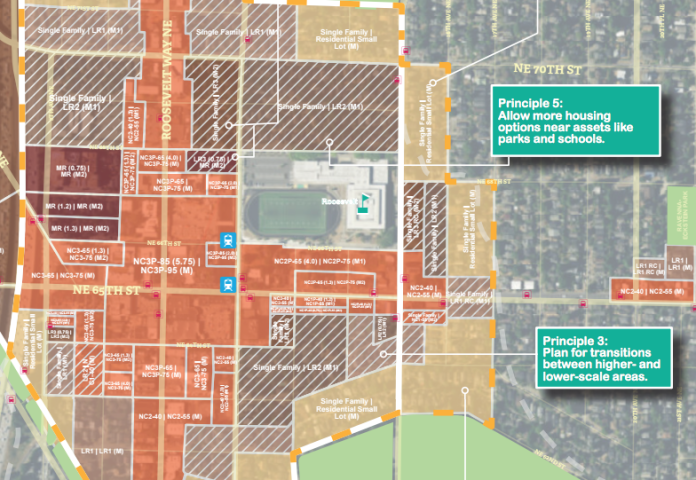In early December last year, community members of the Roosevelt neighborhood met for a community workshop to discuss the draft Mandatory Housing Affordability (MHA) rezones for Roosevelt, a part of the city-wide Housing Affordability and Livability Agenda (HALA). The community workshop was intensely focused on the Roosevelt neighborhood itself looking at what features of the draft plan were valued or needed additional consideration. The Roosevelt Neighborhood Association’s (RNA) Land Use Committee sponsored the workshop and also circulated an online survey open to feedback through early January. By and large, the community provided great detail into priorities on transportation, public space, housing, and livability.
Summing up the findings in a report, the RNA concluded that:
Overall, Roosevelt community members welcome increased density in the neighborhood, though there were a diversity of views on how and where to incorporate new housing units. Opinions were split on a number of issues such as: the effectiveness of transitions, whether the plan will actually increase the number of units and diversity of housing, and if the plan allowed more people to take advantage of community assets.
Many participants were encouraged by the MHA requirements that will increase affordability, though a great deal of people wanted to ensure: (1) affordable “family-sized” units be created in addition to studio and 1BR apartments, and (2) affordable housing be located within Roosevelt, and not simply see developers pay into a fund to create affordable units elsewhere in the city.
There was general support for the increased zoning, particularly near the “urban core,” provided that the plan fostered walkable and pedestrian features and preserved or added community assets. This could be done, for example, by ensuring wider sidewalks and greater setbacks, plus incorporating community gathering spaces into new construction. Lastly, some viewed the Urban Village expansion (particularly east of 15th Ave NE) as “natural”, although there was often strong opposition from many Ravenna community members whose properties would now be located within the urban village and thus impacted by zoning changes.
Priorities By Area
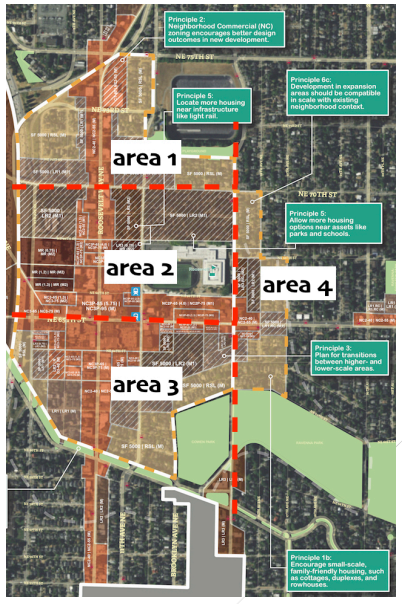
The RNA focused on four different areas that could be affected by MHA zoning changes. Community members indicated varying priorities for each of these:
- Area 1: In this area, community members said that they liked the attributes of walkability, access to transit, and urban design quality through landscaping, architecture, and setbacks. Community members, however, expressed concern about parking issues, pressure for property owners to sell property, development impacting quality pedestrian-oriented structures and uses, and the fate of affordable rental units. Other priorities that community members felt were important included sufficient open space, use of sustainability techniques, and adequate space for students.
- Area 2: In this area, community members expressed a need for more local businesses and transportation investments to accommodate increasing demand. Views on zoning suggested reservations with changes near Cowan Park and mixed opinions on what to do or not do east of 15th Ave NE.
- Area 3: In this area, opinion shared included a perceived lack of transportation connections, desire for zoning changes closer to the neighborhood core, concerns for changing neighborhood character, and skepticism that zoning changes would attain affordable housing. Community members also indicated support for diverse land uses, quality architecture, and mixed housing options. Some suggested that the neighborhood should be given a greater hand in determining the design of new construction and that any new construction along Ravenna Blvd–an Olmsted street–should complement the historic character.
- Area 4: Feedback on what to do about this area was very diverse. Some wanted to maintain the pedestrian experience of the area by creating paths in addition to sidewalks, requiring substantial setbacks and new construction with stoops, and investments in pedestrian safety. Some wanted no changes to zoning east of 15th Ave NE while others suggested urban village expansion toward the Ravenna and Bryant neighborhoods. Community members also identified a need for more community services like parks, libraries, and schools to accommodate growth.
In addition to the feedback in the workshop, community members also had an opportunity to respnd to an online survey on more than a half-dozen topics.
On Transportation

Most respondents felt that the neighborhood has diverse transportation options and that the MHA rezones would be put where those assets are already in place and could be directed in the future. Comments from community indicated that transportation could be improved by:
- Building more bike lanes and bike connections;
- Better coordinated bus service; and
- More on-street parking and bike racks.
On Housing
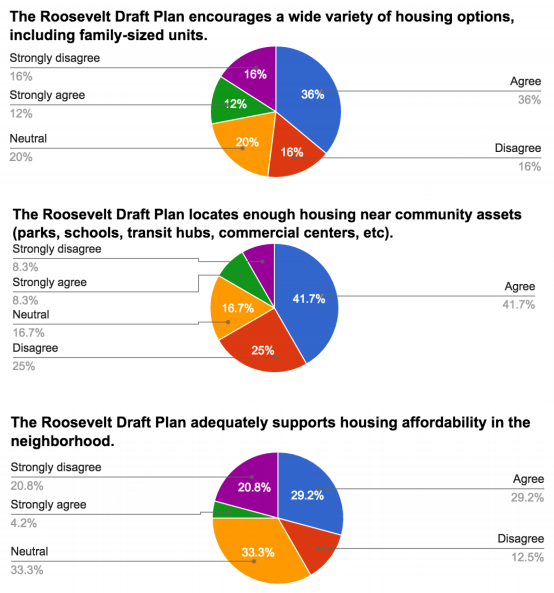
Responding to three different questions on housing, the responses generated differing reactions. Only a small minority felt that the MHA rezones would encourage a wide variety of housing options (including family-sized units) while a great many were skeptical on whether the rezones would deliver affordable housing to the neighborhood. And just 50% thought that the rezones would place enough housing in the right places to benefit from community assets like transit, retail, and schools. Suggested changes by community members included:
- Rejecting the rezones in full;
- Requiring developers to always construct affordable housing units on-site;
- Requiring affordable housing fees paid by developers in Roosevelt to be expended in Roosevelt;
- Adding new housing units to existing structures if structurally feasible;
- Increasing the intensity of density allowed by zoning even further, particular near the light rail station;
- Increasing the mandatory housing affordability requirements in Roosevelt.
On Transitions
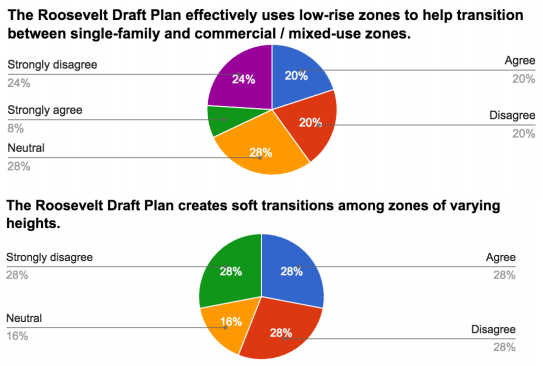
Opinions were mixed on the issue of transition zones like the Lowrise zones between single-family housing zones and commercial and mixed-use zones. Those that did outright favor the MHA zoning approach for Roosevelt were decidedly in the minority. Regarding whether or not the transition zones provided soft height changes, the reaction was even more clear that most felt it wasn’t fine grained enough. Comments on how to better soften the zoning changes included:
- Allowing taller buildings with better landscaping edges;
- Using a “wedding cake” approach and place a Lowrise 2 zone buffer around single-family housing areas;
- Increasing transitions between zoning types and taking a harder look at height changes; and
- Disregarding the issue of transitions altogether.
On Urban Village Expansions

A plurality of respondents expressed skepticism on the issue of whether or not expanded the neighborhood’s urban village boundaries would allow more people to benefit from community assets. But a healthy shares were also neutral and in agreement that the urban village boundaries would be a benefit. Feedback on how to improve the boundary expansion included comments suggesting that:
- Increasing densities in the core retail area and light rail area should be a higher priority with expansions held off until future planning periods;
- Keeping the 15th Ave NE boundary should be a priority;
- Not expanding toward Cowan Park would retain vital demographics and architectural assets; and
- Expanding the boundary past 15th Ave NE as far as 25th Ave NE.
On Community Vitality
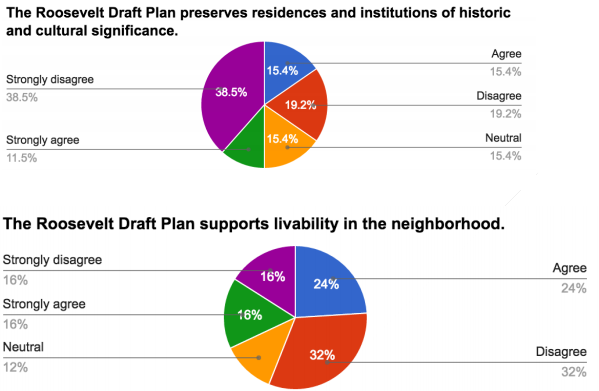
Most respondents didn’t believe that the MHA rezones would preserve places of historic and cultural significance in Roosevelt. But there was mixed opinions on wether or not the rezone would support livability. Comments from respondents included the need for:
- A new plaza next to the light rail stations and an overall increase in community open space;
- A historic preservation plan;
- Keeping zoning low at the periphery of the urban village and high in the core;
- Additional parking to accommodate new development; and
- Developing new design requirements to reflect community character.
What’s clear from this report is that community opinions vary greatly from issue to issue, but on some topics there is consensus. Community feedback and detailed workshops to discuss design and local issues like these are a helpful piece in threading together comprehensive visions. The question, however, is in what ways will they influence refinement of final MHA rezone proposals across city neigborhoods?
Roosevelt Community HALA Report – 3-7-17 by The Urbanist on Scribd
Related Articles
Stephen is a professional urban planner in Puget Sound with a passion for sustainable, livable, and diverse cities. He is especially interested in how policies, regulations, and programs can promote positive outcomes for communities. With stints in great cities like Bellingham and Cork, Stephen currently lives in Seattle. He primarily covers land use and transportation issues and has been with The Urbanist since 2014.

